Shivakumar Raman
Physics-Informed Multimodal Bearing Fault Classification under Variable Operating Conditions using Transfer Learning
Aug 11, 2025Abstract:Accurate and interpretable bearing fault classification is critical for ensuring the reliability of rotating machinery, particularly under variable operating conditions where domain shifts can significantly degrade model performance. This study proposes a physics-informed multimodal convolutional neural network (CNN) with a late fusion architecture, integrating vibration and motor current signals alongside a dedicated physics-based feature extraction branch. The model incorporates a novel physics-informed loss function that penalizes physically implausible predictions based on characteristic bearing fault frequencies - Ball Pass Frequency Outer (BPFO) and Ball Pass Frequency Inner (BPFI) - derived from bearing geometry and shaft speed. Comprehensive experiments on the Paderborn University dataset demonstrate that the proposed physics-informed approach consistently outperforms a non-physics-informed baseline, achieving higher accuracy, reduced false classifications, and improved robustness across multiple data splits. To address performance degradation under unseen operating conditions, three transfer learning (TL) strategies - Target-Specific Fine-Tuning (TSFT), Layer-Wise Adaptation Strategy (LAS), and Hybrid Feature Reuse (HFR) - are evaluated. Results show that LAS yields the best generalization, with additional performance gains when combined with physics-informed modeling. Validation on the KAIST bearing dataset confirms the framework's cross-dataset applicability, achieving up to 98 percent accuracy. Statistical hypothesis testing further verifies significant improvements (p < 0.01) in classification performance. The proposed framework demonstrates the potential of integrating domain knowledge with data-driven learning to achieve robust, interpretable, and generalizable fault diagnosis for real-world industrial applications.
Hybrid Machine Learning Framework for Predicting Geometric Deviations from 3D Surface Metrology
Aug 09, 2025Abstract:This study addresses the challenge of accurately forecasting geometric deviations in manufactured components using advanced 3D surface analysis. Despite progress in modern manufacturing, maintaining dimensional precision remains difficult, particularly for complex geometries. We present a methodology that employs a high-resolution 3D scanner to acquire multi-angle surface data from 237 components produced across different batches. The data were processed through precise alignment, noise reduction, and merging techniques to generate accurate 3D representations. A hybrid machine learning framework was developed, combining convolutional neural networks for feature extraction with gradient-boosted decision trees for predictive modeling. The proposed system achieved a prediction accuracy of 0.012 mm at a 95% confidence level, representing a 73% improvement over conventional statistical process control methods. In addition to improved accuracy, the model revealed hidden correlations between manufacturing parameters and geometric deviations. This approach offers significant potential for automated quality control, predictive maintenance, and design optimization in precision manufacturing, and the resulting dataset provides a strong foundation for future predictive modeling research.
Multimodal Bearing Fault Classification Under Variable Conditions: A 1D CNN with Transfer Learning
Feb 23, 2025Abstract:Bearings play an integral role in ensuring the reliability and efficiency of rotating machinery - reducing friction and handling critical loads. Bearing failures that constitute up to 90% of mechanical faults highlight the imperative need for reliable condition monitoring and fault detection. This study proposes a multimodal bearing fault classification approach that relies on vibration and motor phase current signals within a one-dimensional convolutional neural network (1D CNN) framework. The method fuses features from multiple signals to enhance the accuracy of fault detection. Under the baseline condition (1,500 rpm, 0.7 Nm load torque, and 1,000 N radial force), the model reaches an accuracy of 96% with addition of L2 regularization. This represents a notable improvement of 2% compared to the non-regularized model. In addition, the model demonstrates robust performance across three distinct operating conditions by employing transfer learning (TL) strategies. Among the tested TL variants, the approach that preserves parameters up to the first max-pool layer and then adjusts subsequent layers achieves the highest performance. While this approach attains excellent accuracy across varied conditions, it requires more computational time due to its greater number of trainable parameters. To address resource constraints, less computationally intensive models offer feasible trade-offs, albeit at a slight accuracy cost. Overall, this multimodal 1D CNN framework with late fusion and TL strategies lays a foundation for more accurate, adaptable, and efficient bearing fault classification in industrial environments with variable operating conditions.
Diffusion-Based Approaches in Medical Image Generation and Analysis
Dec 22, 2024Abstract:Data scarcity in medical imaging poses significant challenges due to privacy concerns. Diffusion models, a recent generative modeling technique, offer a potential solution by generating synthetic and realistic data. However, questions remain about the performance of convolutional neural network (CNN) models on original and synthetic datasets. If diffusion-generated samples can help CNN models perform comparably to those trained on original datasets, reliance on patient-specific data for training CNNs might be reduced. In this study, we investigated the effectiveness of diffusion models for generating synthetic medical images to train CNNs in three domains: Brain Tumor MRI, Acute Lymphoblastic Leukemia (ALL), and SARS-CoV-2 CT scans. A diffusion model was trained to generate synthetic datasets for each domain. Pre-trained CNN architectures were then trained on these synthetic datasets and evaluated on unseen real data. All three datasets achieved promising classification performance using CNNs trained on synthetic data. Local Interpretable Model-Agnostic Explanations (LIME) analysis revealed that the models focused on relevant image features for classification. This study demonstrates the potential of diffusion models to generate synthetic medical images for training CNNs in medical image analysis.
Digital Twins in Additive Manufacturing: A Systematic Review
Sep 02, 2024Abstract:Digital Twins (DTs) are becoming popular in Additive Manufacturing (AM) due to their ability to create virtual replicas of physical components of AM machines, which helps in real-time production monitoring. Advanced techniques such as Machine Learning (ML), Augmented Reality (AR), and simulation-based models play key roles in developing intelligent and adaptable DTs in manufacturing processes. However, questions remain regarding scalability, the integration of high-quality data, and the computational power required for real-time applications in developing DTs. Understanding the current state of DTs in AM is essential to address these challenges and fully utilize their potential in advancing AM processes. Considering this opportunity, this work aims to provide a comprehensive overview of DTs in AM by addressing the following four research questions: (1) What are the key types of DTs used in AM and their specific applications? (2) What are the recent developments and implementations of DTs? (3) How are DTs employed in process improvement and hybrid manufacturing? (4) How are DTs integrated with Industry 4.0 technologies? By discussing current applications and techniques, we aim to offer a better understanding and potential future research directions for researchers and practitioners in AM and DTs.
Federated Learning in Healthcare: Model Misconducts, Security, Challenges, Applications, and Future Research Directions -- A Systematic Review
May 22, 2024Abstract:Data privacy has become a major concern in healthcare due to the increasing digitization of medical records and data-driven medical research. Protecting sensitive patient information from breaches and unauthorized access is critical, as such incidents can have severe legal and ethical complications. Federated Learning (FL) addresses this concern by enabling multiple healthcare institutions to collaboratively learn from decentralized data without sharing it. FL's scope in healthcare covers areas such as disease prediction, treatment customization, and clinical trial research. However, implementing FL poses challenges, including model convergence in non-IID (independent and identically distributed) data environments, communication overhead, and managing multi-institutional collaborations. A systematic review of FL in healthcare is necessary to evaluate how effectively FL can provide privacy while maintaining the integrity and usability of medical data analysis. In this study, we analyze existing literature on FL applications in healthcare. We explore the current state of model security practices, identify prevalent challenges, and discuss practical applications and their implications. Additionally, the review highlights promising future research directions to refine FL implementations, enhance data security protocols, and expand FL's use to broader healthcare applications, which will benefit future researchers and practitioners.
Defect Localization Using Region of Interest and Histogram-Based Enhancement Approaches in 3D-Printing
Apr 25, 2024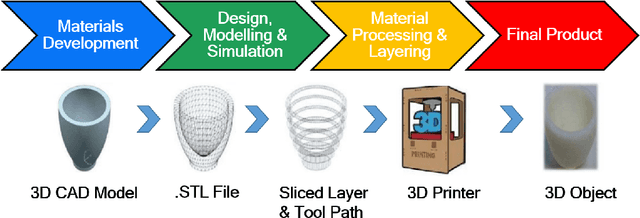
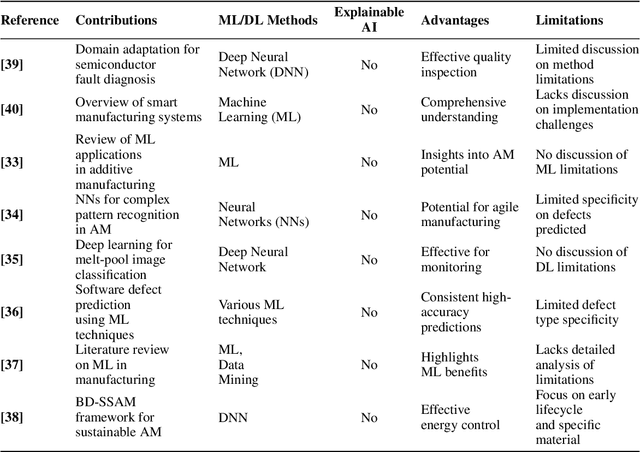
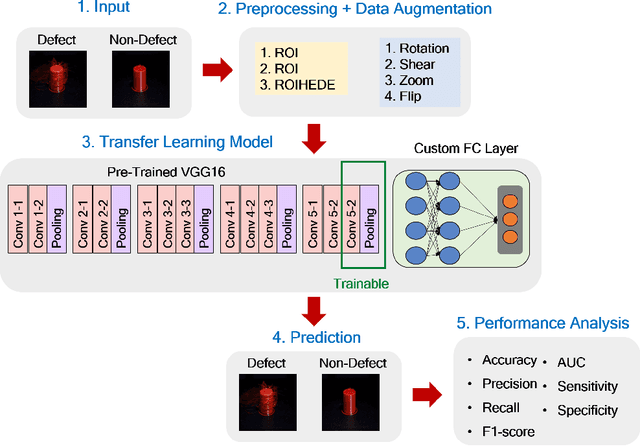
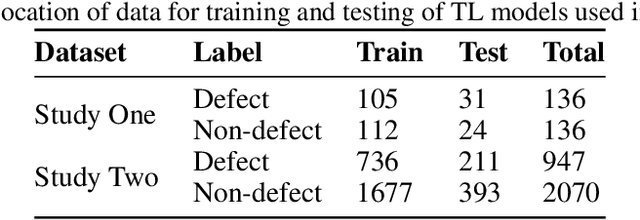
Abstract:Additive manufacturing (AM), particularly 3D printing, has revolutionized the production of complex structures across various industries. However, ensuring quality and detecting defects in 3D-printed objects remain significant challenges. This study focuses on improving defect detection in 3D-printed cylinders by integrating novel pre-processing techniques such as Region of Interest (ROI) selection, Histogram Equalization (HE), and Details Enhancer (DE) with Convolutional Neural Networks (CNNs), specifically the modified VGG16 model. The approaches, ROIN, ROIHEN, and ROIHEDEN, demonstrated promising results, with the best model achieving an accuracy of 1.00 and an F1-score of 1.00 on the test set. The study also explored the models' interpretability through Local Interpretable Model-Agnostic Explanations and Gradient-weighted Class Activation Mapping, enhancing the understanding of the decision-making process. Furthermore, the modified VGG16 model showed superior computational efficiency with 30713M FLOPs and 15M parameters, the lowest among the compared models. These findings underscore the significance of tailored pre-processing and CNNs in enhancing defect detection in AM, offering a pathway to improve manufacturing precision and efficiency. This research not only contributes to the advancement of 3D printing technology but also highlights the potential of integrating machine learning with AM for superior quality control.
Defect Analysis of 3D Printed Cylinder Object Using Transfer Learning Approaches
Oct 12, 2023Abstract:Additive manufacturing (AM) is gaining attention across various industries like healthcare, aerospace, and automotive. However, identifying defects early in the AM process can reduce production costs and improve productivity - a key challenge. This study explored the effectiveness of machine learning (ML) approaches, specifically transfer learning (TL) models, for defect detection in 3D-printed cylinders. Images of cylinders were analyzed using models including VGG16, VGG19, ResNet50, ResNet101, InceptionResNetV2, and MobileNetV2. Performance was compared across two datasets using accuracy, precision, recall, and F1-score metrics. In the first study, VGG16, InceptionResNetV2, and MobileNetV2 achieved perfect scores. In contrast, ResNet50 had the lowest performance, with an average F1-score of 0.32. Similarly, in the second study, MobileNetV2 correctly classified all instances, while ResNet50 struggled with more false positives and fewer true positives, resulting in an F1-score of 0.75. Overall, the findings suggest certain TL models like MobileNetV2 can deliver high accuracy for AM defect classification, although performance varies across algorithms. The results provide insights into model optimization and integration needs for reliable automated defect analysis during 3D printing. By identifying the top-performing TL techniques, this study aims to enhance AM product quality through robust image-based monitoring and inspection.
BSGAN: A Novel Oversampling Technique for Imbalanced Pattern Recognitions
May 16, 2023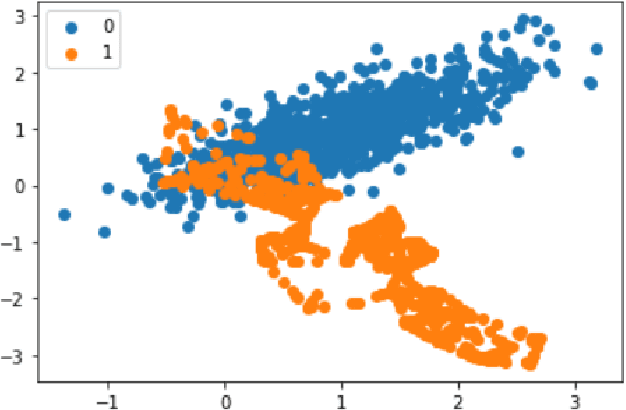
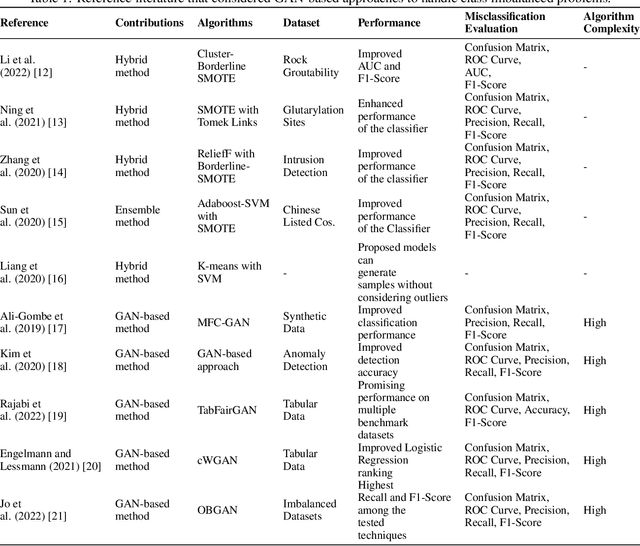
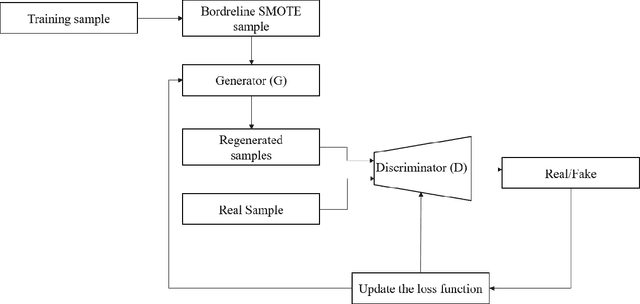

Abstract:Class imbalanced problems (CIP) are one of the potential challenges in developing unbiased Machine Learning (ML) models for predictions. CIP occurs when data samples are not equally distributed between the two or multiple classes. Borderline-Synthetic Minority Oversampling Techniques (SMOTE) is one of the approaches that has been used to balance the imbalance data by oversampling the minor (limited) samples. One of the potential drawbacks of existing Borderline-SMOTE is that it focuses on the data samples that lay at the border point and gives more attention to the extreme observations, ultimately limiting the creation of more diverse data after oversampling, and that is the almost scenario for the most of the borderline-SMOTE based oversampling strategies. As an effect, marginalization occurs after oversampling. To address these issues, in this work, we propose a hybrid oversampling technique by combining the power of borderline SMOTE and Generative Adversarial Network to generate more diverse data that follow Gaussian distributions. We named it BSGAN and tested it on four highly imbalanced datasets: Ecoli, Wine quality, Yeast, and Abalone. Our preliminary computational results reveal that BSGAN outperformed existing borderline SMOTE and GAN-based oversampling techniques and created a more diverse dataset that follows normal distribution after oversampling effect.
Few Shot Learning for Medical Imaging: A Comparative Analysis of Methodologies and Formal Mathematical Framework
May 08, 2023Abstract:Deep learning becomes an elevated context regarding disposing of many machine learning tasks and has shown a breakthrough upliftment to extract features from unstructured data. Though this flourishing context is developing in the medical image processing sector, scarcity of problem-dependent training data has become a larger issue in the way of easy application of deep learning in the medical sector. To unravel the confined data source, researchers have developed a model that can solve machine learning problems with fewer data called ``Few shot learning". Few hot learning algorithms determine to solve the data limitation problems by extracting the characteristics from a small dataset through classification and segmentation methods. In the medical sector, there is frequently a shortage of available datasets in respect of some confidential diseases. Therefore, Few shot learning gets the limelight in this data scarcity sector. In this chapter, the background and basic overview of a few shots of learning is represented. Henceforth, the classification of few-shot learning is described also. Even the paper shows a comparison of methodological approaches that are applied in medical image analysis over time. The current advancement in the implementation of few-shot learning concerning medical imaging is illustrated. The future scope of this domain in the medical imaging sector is further described.
 Add to Chrome
Add to Chrome Add to Firefox
Add to Firefox Add to Edge
Add to Edge